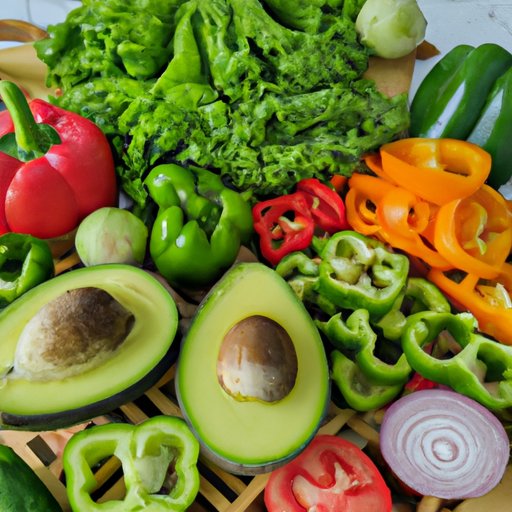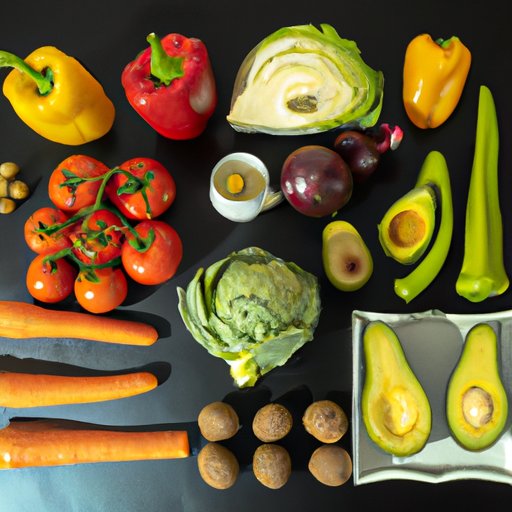Introduction
The keto diet has become increasingly popular in recent years as a way to lose weight, increase energy levels, and improve overall health. In order to follow a ketogenic (or “keto”) lifestyle, you must limit your carbohydrate intake and focus on high-fat, low-carb foods such as meats, fish, eggs, and healthy fats like olive oil and avocados. But what about vegetables? Can they be part of a successful keto diet? The answer is yes!
In this article, we’ll explore what vegetables can you eat on a keto diet, how to incorporate them into your meals, and the nutritional benefits of eating vegetables while on the keto diet.

A Guide to Eating Vegetables on the Keto Diet
Before diving into what vegetables you can eat on the keto diet, it’s important to understand that all vegetables contain some amount of carbohydrates. The trick is to choose vegetables that are low in carbs and high in fiber. This will help keep your carb intake in check without sacrificing important nutrients.
What Vegetables are Allowed on the Keto Diet?
When it comes to vegetables on the keto diet, there are certain types that are considered “low-carb” and should be included in your meals. These include leafy greens, cruciferous vegetables, root vegetables, and other vegetables. We’ll go into more detail about each type of vegetable below.
The Best Low-Carb Vegetables for a Keto Diet
When choosing vegetables for a keto diet, it’s important to select those that are low in carbohydrates and high in fiber. Some of the best low-carb vegetables for a keto diet include:
- Leafy greens (spinach, kale, collard greens, etc.)
- Cruciferous vegetables (broccoli, cauliflower, Brussels sprouts, etc.)
- Root vegetables (carrots, radishes, turnips, etc.)
- Mushrooms
- Cucumbers
- Zucchini
- Avocados
It’s also important to note that some vegetables contain higher amounts of carbohydrates than others. For example, sweet potatoes, corn, and peas are higher in carbs and should be limited or avoided altogether on a keto diet.
How to Incorporate Vegetables into Your Keto Diet
Once you know which vegetables are allowed on the keto diet, the next step is to figure out how to incorporate them into your meals. Here are some meal ideas and tips for cooking vegetables on the keto diet:
- Add leafy greens to smoothies, salads, omelets, soups, and stir-fries.
- Roast cruciferous vegetables with olive oil and herbs for a side dish.
- Make a “zoodle” bowl with zucchini noodles, grilled chicken, and vegetables.
- Sauté mushrooms, onions, and peppers for a quick breakfast or lunch.
- Steam or roast root vegetables for a flavorful side dish.
- Mix cucumbers, tomatoes, and feta cheese for a light salad.
- Grill avocado slices and serve with a squeeze of lime.

The Nutritional Benefits of Eating Vegetables on the Keto Diet
Eating vegetables on the keto diet can provide a wealth of nutritional benefits, including vitamins and minerals, fiber, and healthy fats. Let’s take a closer look at each one:
Vitamins and Minerals
Vegetables are packed with essential vitamins and minerals, including vitamin A, vitamin C, potassium, and magnesium. Eating a variety of vegetables ensures that you get an adequate amount of these vital nutrients.
Fiber
Fiber is an important nutrient for digestion, weight management, and overall health. While most vegetables contain some amount of fiber, leafy greens and cruciferous vegetables are particularly high in fiber. Including these types of vegetables in your diet can help you meet your daily fiber needs.
Healthy Fats
Certain vegetables, such as avocados, are high in healthy fats. Eating foods rich in healthy fats can help you feel full and satisfied after meals, as well as provide important nutrients for overall health.

An Overview of Vegetable Options for the Keto Diet
Now that you know the nutritional benefits of eating vegetables on the keto diet, let’s take a look at some of the best options for a keto diet. Here’s an overview of some of the most common types of vegetables:
Leafy Greens
Leafy greens are some of the most nutrient-dense vegetables available, making them an excellent choice for the keto diet. Examples of leafy greens include spinach, kale, collard greens, and lettuce. Leafy greens can be added to salads, omelets, soups, and smoothies.
Cruciferous Vegetables
Cruciferous vegetables are a family of vegetables that includes broccoli, cauliflower, cabbage, Brussels sprouts, and kale. These vegetables are low in carbs and high in fiber, making them a great option for the keto diet. Cruciferous vegetables can be roasted, steamed, or sautéed for a quick and easy side dish.
Root Vegetables
Root vegetables are another low-carb option for the keto diet. Popular root vegetables include carrots, radishes, turnips, and beets. These vegetables can be boiled, steamed, or roasted for a flavorful side dish.
Other Vegetables
There are plenty of other vegetables that can be included in a keto diet, such as mushrooms, cucumbers, zucchini, and avocados. These vegetables can be eaten raw, added to salads, or cooked in a variety of ways.
Conclusion
Eating vegetables on the keto diet is possible and can provide many health benefits. When selecting vegetables for a keto diet, it’s important to choose those that are low in carbohydrates and high in fiber. Leafy greens, cruciferous vegetables, root vegetables, and other vegetables are all excellent choices. Incorporating these vegetables into your meals can help you meet your daily nutrient needs and stay on track with your keto diet.
Summary of Key Points
- Vegetables can be part of a successful keto diet.
- Choose low-carb vegetables that are high in fiber.
- Incorporate vegetables into your meals with salads, smoothies, omelets, stir-fries, and other dishes.
- Eating vegetables can provide vitamins and minerals, fiber, and healthy fats.
Final Thoughts
Eating vegetables on the keto diet is a great way to get important nutrients while still following the guidelines of the diet. With the right knowledge and meal planning, you can easily incorporate vegetables into your keto lifestyle.
(Note: Is this article not meeting your expectations? Do you have knowledge or insights to share? Unlock new opportunities and expand your reach by joining our authors team. Click Registration to join us and share your expertise with our readers.)
